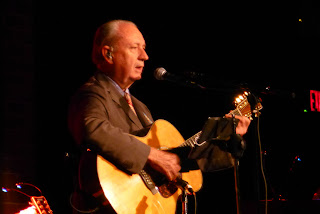Before I get to my reflections on
Round House Theatre's production of How to Write a New Book for the Bible, let me get one thing out of the way: I should have changed my Preview-Thursday subscription (which I've had for 10 years), while I had the chance when I renewed last month for the 2013-14 season. I miss the lovely couple who used to sit next to me, and now I have the loudest talkers sitting behind me.
Stupid people. My fellow subscriber who kept telling her husband how painful it was to sit through
Glengarry Glen Ross in February now spent Act II of
Write/Bible commenting on the "superb acting" of
MaryBeth Wise, portraying the mother dying of cancer. Okay, okay, okay, I totally agree with you, but SHUT.UP.
And while I'm on the subject of rude audiences, you latecomers shouldn't have been admitted. Get here on time! I did! You make everyone wait for you, and a long show runs late on a weeknight. Ushers, please USH! You need to push, and you need to shush.
I'm clearly cranky about all this.
Back to
Write/Bible: And since I'm still cranky, let me get my complaints out of the way. Something I'm really beginning to get annoyed by is reliance on narrative in storytelling. That is, the narrator (in this case the author and character Bill Cain, played amiably by
Ray Ficca), was telling the story about himself
and telling the audience how universal the story is (unlike the Stage Manager in
Our Town telling a universal story and simply setting the characters in motion to illustrate the point).
Photo of Ray Ficca, Mitchell Hébert, MaryBeth Wise, and Danny Gavigan by Danisha Crosby.
The telling part of the storytelling serves a purpose here, which I understand is to convey the
sermon message of the play (more on that in a moment). The other characters have their moments of soliloquizing, too, which means acting to the audience and not to each other. This was the entire approach for RHT's 2011 production of
ReENTRY.
The other directing choice that bothers me is casting actors in multiple roles unnecessarily. As talented as
Mitchell Hébert is (and fun to watch him hop in and out of characters), it was distracting to see him portraying minor female characters. Hire another actress.
Write/Bible (we are told) is an autobiographical play, which author-character Billy explains is the "Mom and Dad" play. It largely revolves around the slow death-by-cancer of the mom, Mary (Wise), who was preceded in death-by-cancer by the dad, Pete (Hébert). Billy, the younger "favorite" (but not really) son does the caregiving duty for his mother while the first son, Paul
(Danny Gavigan), goes off and does what first sons do: make parents proud.
The
sermon message of the play is that we are all writing our own new books of the Bible. Cain's premise is that the Bible should be viewed as a storybook and not a rulebook (I love that message) and that our families and family stories
are new books of the Bible.
This all matters, says Cain. We all matter. (And it is a comforting message when one is feeling particularly insignificant.)
But there were a couple of things that author-character Billy Cain couldn't see, as the teller of his own family story, which were blatantly obvious to me. The first was that his family history of cancer seemed to have no impact on his own sense of health or mortality. Yes, I could relate to his caregiving role, but when I was looking after my own mother after her fall(s), all I could think of the whole time was that this is me in 30 years.
Maybe we shouldn't tell our own stories. Maybe we're too myopic. The other thing Cain missed was the brother (and hey, is
Cain not an appropriate name?). There is a big stretch in Act I where we see Paul (Gavigan) going off to fight in Vietnam. He misses one week of regular letter-writing to the family, and when he comes home, shaken up, we eventually learn why (an incident involving a battle and a buddy). Then, in Act II, we learn that he has become a teacher and is mentioned on TV when several of his former students have gone on to some kind of noteworthy success.
There's a big gaping gap between these plot points; the Act I sequence (I admit to being distracted while watching handsome Gavigan change into his Army uniform) was actually worthy of an entire play, to wit,
ReENTRY. I realize the Mom and Dad play can only have so much big brother in it (enough with the Jesus, Mary, and Joseph references, thanks), but I couldn't help feeling that the big brother mattered less than the younger brother-author-character wanted to admit (that is, mattered less to him, but more to the new book of the Bible). Useful for wrapping up the
sermon message, though.
Since we last saw Gavigan playing another soldier in
Bengal Tiger at the Baghdad Zoo, it's natural to draw comparison to that performance: They were completely different. Different characters, different responses to the war and postwar scenarios and traumas. And an actor worth watching at all times.
So anyway, in
Write/Bible, the dark family "secret" that would have made a compelling focus (Paul at war, Paul after war) was unfortunately buried in a subplot.
Or maybe that's just me. And of course, when invited, one thinks of one's own family books of the Bible that should be written. We all have something that needs to be said, and one day I'll try to write about my own brother's monsters and traumas and tragedies. But not yet. I'm still trying to learn from (of?) life.
love, hosaa
unsermonizing


















